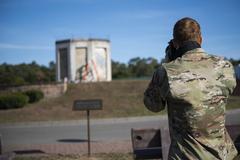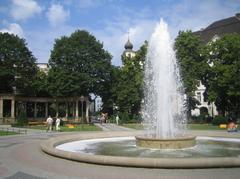
Borsig-Villa Reiherwerder: Visiting Hours, Tickets, and Berlin Historical Sites Guide
Date: 04/07/2025
Introduction
Nestled on the tranquil Reiherwerder peninsula along Berlin’s Tegeler See, the Borsig-Villa Reiherwerder stands as a striking symbol of Germany’s industrial heritage and diplomatic history. Commissioned by the pioneering Borsig family in the early 20th century, the villa combines architectural grandeur with natural elegance, reflecting Berlin’s traditions of garden culture and innovation. Today, it serves as the official guesthouse of the German Federal Foreign Office and the seat of the Akademie Auswärtiger Dienst, making it a vital venue for international diplomacy. Though public access is rare due to its governmental role, special events and open house days offer unique opportunities to explore its rich past and architectural beauty. This guide provides detailed insights into the villa’s history, architecture, legacy, visiting policies, and nearby attractions, ensuring that history enthusiasts and cultural travelers can make the most of any opportunity to experience this unique Berlin historical site.
For more detailed information, consult official resources such as the German Federal Foreign Office and scholarly research on the Borsig estate.
Table of Contents
- Introduction
- Origins of the Borsig-Villa Reiherwerder
- Architectural Vision and Features
- The Borsig Family and Their Legacy
- The Villa’s Role in Berlin’s Cultural and Natural Heritage
- History Through the 20th Century
- Borsig-Villa Reiherwerder Today: Diplomatic Role and Access
- Frequently Asked Questions (FAQ)
- Conclusion
- Explore More
- References
Origins of the Borsig-Villa Reiherwerder
The villa’s history dates back to the early 20th century, when the Borsig family—luminaries of German locomotive manufacturing—purchased the Reiherwerder peninsula in 1903 (source). Seeking a tranquil residence away from the industrial bustle, they chose a site renowned for its natural beauty, clean air, and privacy. The move coincided with the rapid development of the Tegel area, including the introduction of electric trams and the completion of the Borsighafen, integrating the region more closely with Berlin’s urban fabric.
Architectural Vision and Features
Design and Construction
The Borsigs commissioned August Blunck, a noted Berlin architect, to design a villa that would blend harmoniously with the lush surroundings. The estate included not only the main villa but also a rustic boathouse and an icehouse near the shore (source). The villa’s location was carefully selected to ensure privacy, with the building hidden from public promenades and the Malche Bay.
Architectural Style
The villa is an elegant example of early 20th-century German architecture, merging Baroque revival and English country house influences. Notable architects Alfred Salinger and Eugen Schmohl contributed to its castle-like grandeur, with a stately portico, classical columns, and symmetrical facades (raz-zeitung.de). The interiors feature lavish rooms, including a library with original Siena marble fireplaces, Jugendstil bathrooms, and sweeping views over the Tegeler See from large windows.
Landscape Architecture
After the villa’s completion, the surrounding park was developed with both Baroque and English landscaping elements. The formal gardens feature geometric layouts and manicured hedges, while the larger parkland boasts mature oaks and meandering paths, reflecting contemporary trends in garden design (raz-zeitung.de).
The Borsig Family and Their Legacy
The Borsig family, led by August and later Ernst von Borsig, rose to prominence through innovations in locomotive manufacturing. They became known for their commitment to social welfare, providing housing and support for workers, and introducing childcare facilities during World War I (source). Their patronage extended to artists and architects, and their estates became centers of cultural and social activity in early 20th-century Berlin.
The Villa’s Role in Berlin’s Cultural and Natural Heritage
The Borsig-Villa Reiherwerder epitomizes Berlin’s tradition of integrating architecture with nature. The family contributed to the region’s biodiversity, actively supporting local flora and fauna, and engaging with landscape architects to develop the estate’s gardens. The villa also served as a gathering place for leading figures in the arts and sciences, embedding it within the intellectual life of Berlin (source).
History Through the 20th Century
The villa’s fate reflected Berlin’s turbulent history. The original Borsig family estate in Moabit was lost amid urban expansion. Reiherwerder survived both world wars and postwar division, eventually becoming a government property. In the Nazi era, the estate was used as the Reichsfinanzakademie. Following World War II, it served as the headquarters of the French occupation forces, and from 1951, it became property of the Federal Republic of Germany, later hosting the German Foundation for Developing Countries (raz-zeitung.de).
Borsig-Villa Reiherwerder Today: Diplomatic Role and Access
Diplomatic and Governmental Functions
Since 2006, the villa has been the official guesthouse of the German Federal Foreign Office and the seat of the Akademie Auswärtiger Dienst. It is a central venue for diplomatic meetings, international conferences, and training for diplomats (Die Dorfzeitung; Villa Borsig Data PDF, p. 29). The Seepavillon, constructed in 1958, now serves as an event and dining space for state functions.
Visiting Hours and Tickets
The villa is a secure government facility and not open for regular public visits. However, it participates in the annual “Tag der offenen Tür” (Open House Day), usually held in late August. On this day, visitors can tour select areas of the villa and gardens, attend guided tours, and learn about its diplomatic functions. Admission is free, and no advance tickets are required, but visitor capacity is limited (Die Dorfzeitung).
Accessibility
Efforts are made to accommodate visitors with disabilities during public events; however, as a historic property, some areas may be difficult to access. Contact event organizers in advance for specific accommodations (Die Dorfzeitung).
Directions and Transportation
- Location: Reiherwerder peninsula, Berlin-Tegel, in the Tegeler See.
- Public Transport: Reachable via Berlin-Tegel U-Bahn and S-Bahn stations, with connecting bus or taxi services.
- Parking: Extremely limited; use public transport when possible.
- Entrance: Via “Schwarzer Weg,” a historic path linking the peninsula to the mainland (Villa Borsig Data PDF, p. 13).
Special Events and Guided Tours
During the Open House Day, guided tours and historical exhibitions are offered, highlighting the villa’s architecture and diplomatic history. No other public tours are available throughout the year.
Nearby Attractions
While direct access to the villa is limited, visitors can enjoy several nearby sites:
- Tegeler See and Greenwichpromenade: Lakeside walks, boat tours, and scenic views (Berlin.de).
- Tegel Forest Landscape Conservation Area: Nature trails and wildlife observation (Villa Borsig Data PDF, p. 23).
- Borsigwerke: Historic industrial complex in Tegel.
- Schloss Tegel (Humboldt-Schloss): Seasonal guided tours (Schloss Tegel).
- Schloss Sanssouci, Potsdam: Palace inspiration for the villa (Wikipedia).
Photography and Viewing
Photography inside the villa is generally prohibited due to security. The villa and gardens are hidden from public roads by woodland and water; only distant glimpses are possible from across Tegeler See. Drone usage is forbidden (Berlin.de).
Frequently Asked Questions (FAQ)
Q: When can I visit Borsig-Villa Reiherwerder?
A: Only during the annual Open House Day in late August; otherwise, the villa is closed to the public.
Q: Are tickets required?
A: No, entry during Open House Day is free and unticketed, but capacity is limited.
Q: Are guided tours available?
A: Guided tours are offered on Open House Day only.
Q: Is the villa accessible for people with disabilities?
A: Accommodations are made during public events, but some historic areas may be inaccessible.
Q: Can I visit or book private tours at other times?
A: No, private tours or regular visits are not available.
Q: Where can I see the villa from?
A: Distant views are possible from across Tegeler See, but the estate is not visible from roads.
Q: Are there alternative villas in Berlin to visit?
A: Publicly accessible historic villas include Villa Oppenheim and Villa Liebermann.
Conclusion
Borsig-Villa Reiherwerder stands as a living testament to Berlin’s industrial ingenuity, architectural refinement, and diplomatic significance. While regular public access is restricted, the annual Open House Day and curated cultural events offer rare glimpses into this storied estate. By exploring nearby sites and digital resources, visitors can appreciate the legacy of the Borsig family and the villa’s ongoing role in German diplomacy.
For the latest updates, consult the German Federal Foreign Office and Berlin tourism portals, and consider virtual tours or the Audiala app for an enriched experience.
Explore More
Enhance your journey through Berlin’s historical sites by exploring related articles, virtual tours, and curated travel tips on our platform. Download the Audiala app for real-time updates, exclusive content, and guided tours. Follow us on social media for news and insights on Berlin’s cultural treasures.
References and Further Reading
- Borsig-Villa Reiherwerder: History, Visiting Information, and Cultural Significance of a Berlin Historical Site (PDF)
- Villa Borsig: Visiting Hours, Tickets, and History (raz-zeitung.de)
- Visiting Borsig-Villa Reiherwerder: Hours, Tickets, and Visitor Information (Die Dorfzeitung)
- Practical Visitor Information (Auswärtiges Amt PDF)
- Berlin.de: Borsig-Villa Reiherwerder tourism article
- Wikipedia: Borsig-Villa Reiherwerder entry
- Schloss Tegel (Humboldt-Schloss)


